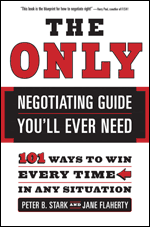Summary: Walking away from an unacceptable deal.
In any relationship, the side with the least commitment to continuing the relationship has the most power. Being able to walk away from the bargaining table when the tide turns against you gives you leverage.
Example
Kathleen wants to buy a daybed for her daughter. The bed has been advertised for $177. When Kathleen starts to pay for the bed, the salesman tells her there is an additional $25 delivery fee. Kathleen doesn’t want to pay the fee, since her husband can pick up the bed in his company truck. The salesman agrees to waive the delivery charge.
A week later when Kathleen and her husband go to pick up the bed, the clerk behind the counter states that the person Kathleen talked to previously did not have the authority to remove the delivery charge. After going back and forth, Kathleen finally says, “Just give me my $177 back and we’ll buy the bed somewhere else.”
Counter
If someone uses These Boots Are Made for Walking on you and you can meet your goals without that person (e.g., other people are interested in your product or service), let your counterpart walk. In the example above, the clerk apparently thinks the store can sell the bed to someone else for the full price plus delivery charge, so he is not concerned that Kathleen is walking away. If he decides that waiving the $25 charge is a small concession to make, he may utilize the tactic of Losing the Battle to Win the War. But if the clerk ends up chasing after Kathleen and bringing her back to the bargaining table, his power will deteriorate considerably. Car salespeople are notorious for going after customers when they start to walk away. Remember, if you keep walking, the leverage will be on your side, as long as you have a way of contacting your counterpart again should you desire.
Have you used or encountered this tactic in your negotiations? If so, how’d it go?
 One of our teammates is in the market to buy a condominium. It wasn’t that long ago that it was darn near impossible to even give away a piece of real estate. On the street where I live, there’s a house that’s in foreclosure that has been on the market for close to three years. But, in some sections of the real estate market, like condominiums, the market has done a 180 and sellers are now receiving multiple offers at prices significantly higher than their asking price.
One of our teammates is in the market to buy a condominium. It wasn’t that long ago that it was darn near impossible to even give away a piece of real estate. On the street where I live, there’s a house that’s in foreclosure that has been on the market for close to three years. But, in some sections of the real estate market, like condominiums, the market has done a 180 and sellers are now receiving multiple offers at prices significantly higher than their asking price.


